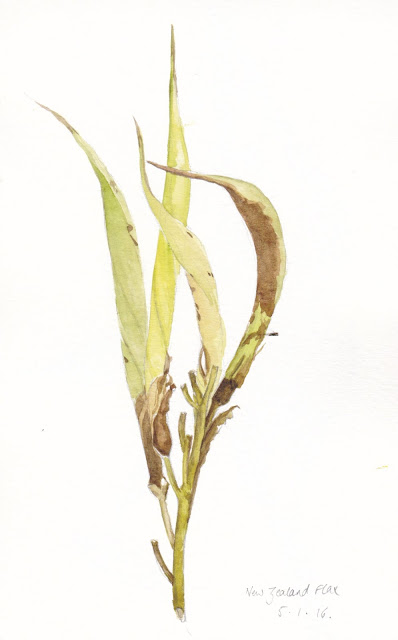I have been cleaning and filling may various watercolour palettes ready to teach a 5-day workshop in Bathurst, so I thought I'd take a couple of photos of them. They all contain mostly the same colours though they each have a different purpose.

The first is my teaching palette. This is a Herring Compact half pan palette, set up with the thumb hole and brush space filled so it contains 32 colours instead of the intended 16 half pans - that's a lot! More than I'd use in any paintings but useful for demonstrating.
I have it set up with a cool, mid and warm yellow so I can show the differences quickly in how they look and how they mix. It has both the RS and GS versions of Phthalo blue, a Yellow ochre as well as Raw sienna, Goethite and Quinacridone gold to easily show how the various earth yellows behave and mix differently.
It also has a lot of colours including orange and purples that I don't normally have in my regular palette, so I can show how to neutralise colours quickly. I certainly don't suggest that such a large range of colours is in any way necessary, but it's helpful for my teaching :-)
On the right is a brass paint box palette that I use in my studio. It has my 20-colour regular palette colours (more detail
here). I can mix any colour I want with these, but sometimes I want to do something a little different in my studio so I have a little palette of 'extras' for added texture. This also lives in my studio and contains some Primatek pigments and some extra convenience colours that I like for special purposes, including some from my teaching palette.
The bottom row has my 'Tardis' brass palette - so named because it has a lot of colours in a small space :-) I take this with me for plein air sketching and travelling and it is my outdoor workhorse palette. It contains my studio 20 colours as well as some extras for special purposes - Raw Sienna for people or the glow of sunsets, Rich green gold for foliage, along with Transparent red oxide and Piemontite genuine - interesting granulating colours that are great for rusty effects and landscape textures.
Next is my 'Little Lady' brass palette - this lives in my handbag so I always have it with me. Best for pocket or A5 sized sketches, it is very cute but also remarkably practical. It contains my 20-colour palette along with some other extras - Serpentine genuine for instant grassy meadows, Cobalt Turquoise for copper effects on buildings, and Green apatite genuine for wonderful foliage effects. It currently has Moonglow as the 4th colour but that may switch to the lovely granulating Lunar black or the opaque yellow ochre. The 'extras' spots in this little palette can swap around thanks to
David's inventiveness - very clever :-)
The final palette is an Italian metal full pan palette that I picked up on sale and have only recently set up for teaching and demonstrating with larger brushes. My studio palette, which doesn't normally leave the house, has good access for larger brushes but the others are better for smaller brushes. This final palette basically contains my ultimate mixing set with a couple of extras, though it has a real mix of brands where the others are totally Daniel Smith. It has a genuine Quin Gold PO49 from W&N - old stock I found from before they ran out of that pigment, a Schmincke pure yellow I was testing, quite a few Da Vinci paints, and some Daniel Smith for the rest of the colours. It's large for plein air but may work out well for teaching.
The first photo shows them open. Here they are closed.

In all there are 38 pigments that I like to have available in my studio. I'd use about 10 to 15 of them most of the time, mostly my
ultimate mixing set, and in most paintings I may use only 5 - 7 pigments. However one of the joys of watercolour is that it isn't just about the colour, it's about the wonderful textures you can achieve with a granulating colour, or the different appearance of a transparent vs an opaque colour in a mix. I love to explore all of the characteristics of watercolour in my painting.
To see more palette ideas, have a look at my website
here.
















 In Cambridge with my daughter, we rented some bikes and rode to Grant Chester, a charming little village, and also caught a train to Ely.
In Cambridge with my daughter, we rented some bikes and rode to Grant Chester, a charming little village, and also caught a train to Ely.















